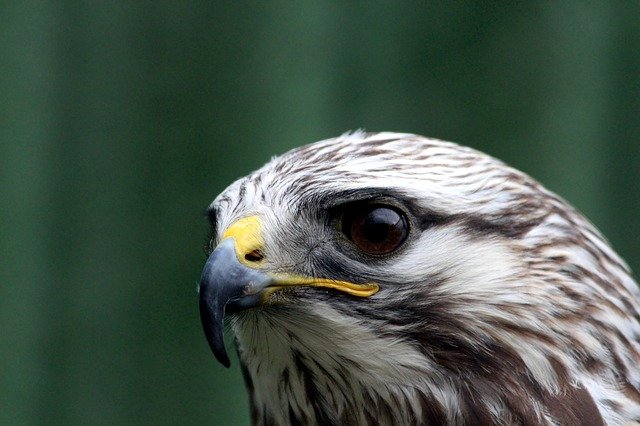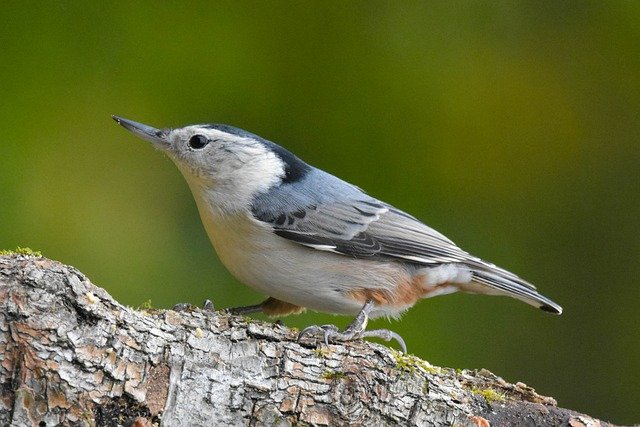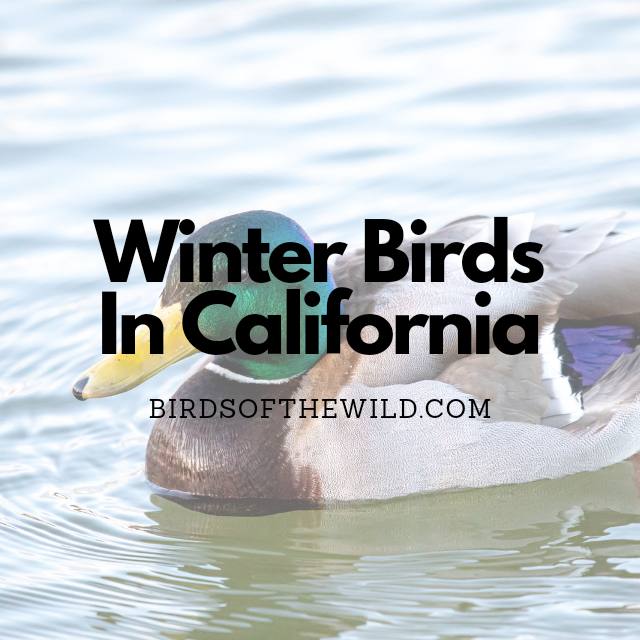In this article I’ll be going over 9 winter birds that can be found in the state of California so continue reading to learn more about these birds below.
- Bald Eagle
- Golden Eagle
- Rough Legged Buzzard
- Mallard
- White Breasted Nuthatch
- Great Horned Owl
- Northern Flicker
- Rock Pigeon
- Northern Cardinal
9 Winter Birds In California
1. Bald Eagle (Haliaeetus Leucocephalus)

- Size: 90 – 108cm
- Weight: 3 – 6.3kg
- Wingspan: 180 – 250cm
Bald eagles are fall and winter non-breeding residents within the majority of California.
A bald eagle’s plumage consists of dark brown around its wing and body, with white feathers on its tail and head along with the trademark yellow beak and feet. Both male and female bald eagles look relatively the same.
As for where you can find these eagles, it will often be around lakes and reservoirs with lots of fish and surrounding forests. You’ll often find them around unfrozen lakes and hunting along coastlines, reservoirs, and rivers during the winter months
These eagles are birds of prey meaning they hunt other birds, medium sized mammals like rabbits, hares, other animals like reptiles, fish and even eat carrion when their options are limited. Sometimes bald eagles are recognised as fish eagles as their diet consists of fish and as meat is the only thing they eat these eagles would ultimately be regarded as carnivores too.
Bald eagles can live for around 20 years in the wild.
2. Golden Eagle (Aquila Chrysaetos)

- Size: 70 – 82cm
- Weight: 3.7 – 5.3kg
- Wingspan: 190 – 212cm
Golden eagles can be found in the majority of California in the fall and winter months when they aren’t breeding.
These eagles are recognised by their mostly light brown and dark brown plumage, yellow feet and black downwards pointing beak. Females once again are the larger of the 2 birds where males are roughly 33% smaller in size.
These eagles spend the majority of their time within open moorlands and mountains within the likes of Scotland, and many areas within north America
Golden eagles do eat carrion but, it isn’t their first choice of food when hunting for prey. If they do find a dead carcass they will eat it, with their general food choices consisting of smaller mammals, birds and sometimes larger prey.
These eagles are known to live for around 14 years in the wild whilst captive are even able stay alive till their early 30’s with the longest observed at 32 years old.
3. Rough Legged Buzzard (Buteo lagopus)

- Size: 46 – 59cm
- Weight: 0.6 – 1.3kg
- Wingspan: 120 – 150cm
Rough legged buzzards can be found in the majority of California in their non-breeding season. This typically will encompass the fall and winter months.
These buzzards are recognised by their brown and white plumage where their wings are brown, their neck and head black and the underside of their belly and wings with elements of brown but, mostly white in color. Females are generally just the larger of the 2.
You’ll often find rough legged buzzards around bogs and mountainous heathland areas, or in clearings in coniferous woodlands.
As for what these buzzards eat, it includes birds, reptiles, amphibians, larger insects among other smaller rodents and mammals.
These hawks can live for around 19 years in the wild.
4. Mallard (Anas Platyrhynchos)

- Size: 50 – 65cm
- Weight: 0.72 – 1.6kg
- Wingspan: 81 – 98cm
Mallards can be spotted all throughout California in the winter months.
You’ll be able to recognise mallards by their dark, iridescent green head, brown neck, brown stripes upon the upper level of the wing with the remainder of their body a cream/white color. Females on the other hand are a mostly light brown patterned color with both male and females having orange webbed feet.
Mallards prefer calm, shallow sanctuaries, but can be found in almost any body of freshwater, which can include wetlands, saltwater and brackish water.
These ducks tend mostly to consume seeds, acorns and berries, plants, insects and shellfish.
In regards to lifespan, these mallards are known to live for around 5 – 10 years in the wild.
5. White Breasted Nuthatch (Sitta Carolinensis)

- Size: 13 – 14cm
- Weight: 18 – 30 grams
- Wingspan: 20 – 27cm
White breasted nuthatches can be found in the majority California on a year round basis, which includes the winter months.
These white breasted nuthatches are recognised by their gray back, wings and the upper head with white breast feathers. Females look the same as the males.
As for where you would find these white breasted nuthatches, it would be around mature woods and woodland edges, where they’re most commonly located by deciduous stands that have maple, hickory, basswood, oak and are even found in some coniferous forests.
They mostly consume nuts, seeds and insects, which can include hazelnuts, sunflower seeds and suet.
As for how long white breasted nuthatches live in the wild, it tends to be around 2 years with the longest lifespan recorded around 12 years.
6. Great Horned Owl (Bubo Vrginianus)

- Size: 57 – 63cm
- Weight: 1.4 – 1.5kg
- Wingspan: 1.35 – 1.5m
Great horned owls can be found all across California year round including the winter months.
These large horned owls are recognised by their brown/gray plumage with their defining feature being the tuft of feather on the top of their head resembling a horn or ear like feature. Male and female great horned owls look relatively the same with the females slightly larger in size.
At night these birds will perch on a branch or a tall building to look around for prey and once the desired prey has been found they will fly towards it with folded wings, grab the prey with their talons piercing through their body and in most cases killing them immediately.
As for what these birds eat it includes smaller prey like rodents, frogs or scorpions. Even other larger predators like geese, ducks, hawks, and smaller owls can be eaten by these carnivorous birds.
Great horned owls are most commonly found in deserts, wetlands, forests, grasslands, backyards, cities and they can also be found in semi-open habitats between the Arctic and the tropics.
As for a great horned owls lifespan, it can be anywhere from 15 -25 years.
7. Northern Flicker (Colaptes Auratus)

- Size: 30 – 35cm
- Weight: 115 – 125 grams
- Wingspan: 50 – 55cm
These northern flickers can be found all across California in the winter months.
Northern flickers are recognised by their mostly cream colored body with black spots, orange and black tail feathers and elements of red on the lower part of their face. Females look very similar to the males minus the red elements on their face.
You’ll often find northern flickers around woodlands, forest edges, and open fields with scattered trees, as well as city parks and suburbs.
As for what they tend to eat, it includes mostly insects along with smaller fruits and berries.
Northern flickers are known to live for around 5 – 7 years on average with the longest recorded to be 9 years and 2 months.
8. Rock Pigeon (Columba Livia)

- Size: 30 – 36cm
- Weight: 265 – 380 grams
- Wingspan: 50 – 67cm
You’ll find rock pigeons scattered all across California on a year round basis, including the winter months.
Rock pigeons are mostly gray with elements of black on their wings and green plus purple hue across their neck. Females are generally smaller in size and also have a flatter head unlike the males who tend to have a more round head shape.
These pigeons spend the majority of their time around urban parks and neighborhoods, around farms, under highway, railroad bridges as well as near tall rocky cliffs.
In regards to the food rock pigeons eat, they include a variety of seeds, bread crumbs, seed grasses, worms among other insects, berries and acorns.
Rock pigeons tend to live for 6 years in the wild when averaged out.
9. Northern Cardinal (Cardinalis Cardinalis)

- Size: 21 – 23cm
- Weight: 42 – 48 grams
- Wingspan: 30 – 35cm
You’ll be able to find northern cardinals in the southeast region of California year round, which would also encompass the winter months.
Northern cardinals are recognised by their mohawk-like head feathers, red exterior and beak with elements of black across the face. Females also have elements of red on their beaks and their body but, in smaller amounts, with the majority of their plumage a light brown color.
These cardinals can be found in woodlands, gardens, shrublands, wetlands and backyards if the sugar water or seeds in the feeders satisfy their taste buds.
As for the food they eat, it consists of small insects like beetles, true bugs, grasshoppers, caterpillars, ants, flies, spiders, centipedes, and snails. Seeds of weeds, berries among other smaller fruits are part of their diet too.
Northern cardinals are known to live for around 15 years in the wild although the actual number probably a lot less.
Amhil Khan, a dedicated nature enthusiast and the founder of BirdsOfTheWild.com, is a passionate advocate for the captivating world of avian wonders. With a deep-seated curiosity about the intricate lives of birds, Amhil’s journey began as a fascination and has evolved into a mission to inspire others to appreciate and protect these magnificent creatures.
Amhil’s love for birds led to the creation of Birds of the Wild, a platform where his expertise in ornithology, coupled with his captivating storytelling, provides readers with an immersive and educational experience. Through his lens and words, he captures the essence of birds in their natural habitats, offering a glimpse into their behaviors, migrations, and the ecosystems they inhabit.

